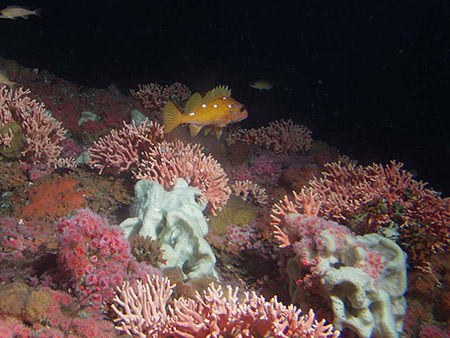Climate Change and Ocean Acidification
Cordell Bank

Why is it a concern?
Climate change is projected to profoundly impact coastal and marine ecosystems and is expected to have significant effects on sea temperature, sea level, storm intensity, and ocean chemistry. Some anticipated changes are more damaging storms, more extreme floods and droughts, and a northward shift in the ranges of at least some species. It is also possible that some organisms will move to deeper, cooler water. If the rate of northward migration of some species is too slow to keep pace with the environmental changes, these species will adapt, live under suboptimal conditions, or vanish locally. Regardless, the composition of local species assemblages is expected to change.
An increase in the amount of CO2 in the atmosphere has lead not only to increased temperatures on Earth, but also to higher levels of dissolved CO2 in the world's oceans. The additional CO2 has lowered the pH of the oceans (a condition termed ocean acidification). Ocean acidification will be detrimental to many marine organisms, including mollusks, corals, and certain shell-producing plankton which rely on carbonate from seawater to build their shells and other hard parts. Scientists have documented that nearshore waters in the California Current system already have a low carbonate saturation state linked to coastal upwelling processes, as seasonal upwelling brings corrosive deep water (enriched in CO2 and undersaturated with respect to aragonite) closer to the surface and near the coast. It is unclear how increased ocean acidification related to climate change will impact organisms that have evolved in a lower pH upwelling environmentOverview of Research
Research conducted by Sanctuary scientists and partners provides critical information to address existing and emerging resource conservation and management issues. The Overview of Research highlights some, but not necessarily all, of the research activities completed or ongoing at the Sanctuary.
Cordell Bank sanctuary is working jointly with Greater Farallones sanctuary to develop a long-term climate change site scenario for the sanctuary. The primary purpose of this document is to gather and synthesize existing information on climate change drivers and potential impacts to marine communities and ecosystems. . In addition to this document, the Cordell Bank National Marine Sanctuary also conducts monitoring and research with GFNMS and partners on ocean acidification, hypoxia, and other climate change issues within sanctuary waters.
| Project Name | PI and contacts | Links |
|---|---|---|
|
Climate Change Scenario |
Kelley Higgason, Catherine Marzin et al. |
|
Applied California Current Ecosystem Studies (ACCESS) |
||
Dissolved oxygen monitoring at Cordell Bank |
Science Needs and Questions
The best available science is used by Sanctuary scientists and managers working to address priority resource conservation and management issues. As priorities change and new issues emerge, each Sanctuary develops new science needs and questions and works with partners to address them.
- See the CBNMS Science Need Assessment related to Climate Change for additional information.
- What is the climatology of the sanctuary?
- How will changes in upwelling intensity and timing impact krill populations and larval dispersal and recruitment of rockfishes and invertebrates?
- How will changes in upwelling intensity and timing impact distribution, abundance, timing of arrival and departure, and residence times of seabirds and marine mammals?
- Does species composition change in response to rising sea surface temperature?
- What is the aragonite saturation horizon of CBNMS and how does it vary seasonally and in response to long term climate change?
- How will ocean acidification impact the sanctuary and directly affect various species, including deep water corals, larval fish and crustaceans, krill, and other calcifying invertebrates?
- What are the characteristics of the oxygen minimum zone at Cordell Bank?
-
What are the conditions of dissolved oxygen at surrounding Cordell Bank, what factors influence variability, and how will changes in dissolved oxygen impact Cordell Bank communities?
Education and Outreach Material
Please refer to the Cordell Bank National Marine Sanctuary website to learn more about education and outreach materials.
References
Chavez, F.P., J. Ryan, S.E. Lluch-Cota and M. Niquen. 2003. From anchovies to sardines and back: multidecadal change in the Pacific Ocean. Science 299: 217-221
Feely, R.A., C.L. Sabine, K. Lee, W. Berelson, J. Kleypas, V.J. Fabry, F.J. Millero. 2004. Impact of anthropogenic CO2 on the CaCO3 system in the oceans. Science 305:362-366.
Feely, R.A., C.L. Sabine, J.M. Hernandez-Ayon, D. Lanson, B. Hales. 2008. Evidence for upwelling of corrosive "acidified" water onto the continental shelf. Science 320:1490-1492.
Levitus S., Antonov J.I., Boyer T.P. and Stephens C. 2000. Warming of the world ocean. Science 287: 2225-2229

